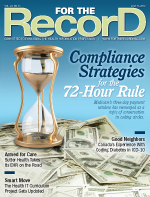 July 16, 2012
July 16, 2012
Coding for Measles
For The Record
Vol. 24 No. 13 P. 26
Measles is a highly contagious viral infection that typically affects children but can easily be prevented with a vaccine. Also called rubeola, the disease was almost eliminated in the United States; however, its occurrence is increasing with parents deciding not to vaccinate their children.
Common symptoms of measles are fever; dry cough; runny nose; conjunctivitis; sore throat; sensitivity to light; red, blotchy skin rash (some spots may be slightly raised); and Koplik’s spots (tiny white spots with bluish-white centers located on the inner lining of the cheek).
The viral illness occurs in stages as follows:
• Incubation period: seven to 14 days after exposure to the virus with no symptoms.
• Nonspecific signs and symptoms: mild illness lasting for two to three days.
• Acute illness and rash: The rash first breaks out on the face, then spreads down the arms and trunk, eventually affecting the thighs, lower legs, and feet. Fever also spikes to 104˚ to 105˚F.
• Communicable period: The disease remains contagious for four days before the rash appears until four days after the rash first appears.
Measles is classified to ICD-9-CM category 055 and includes morbilli and rubeola. The fourth-digit subcategory depends on whether the patient experienced a complication with the measles, such as encephalitis (055.0), pneumonia (055.1), otitis media (055.2), or keratoconjunctivitis (055.71).
Measles with other specified complications is classified to code 055.79, whereas measles with unspecified complications is assigned to 055.8. Assign code 055.9 for unspecified measles or for measles without mention of complication.
German Measles
German measles, also called rubella, is another virus that causes a rash on the skin. Also highly contagious, rubella may infect a patient from one week before the rash begins until one to two weeks after the rash is gone. Besides the rash, symptoms of German measles include fever, headache, malaise, runny nose, inflammation of the eyes, muscle/joint pain.
German measles is classified to category 056, Rubella. The fourth and fifth digits are required to specify the complication, such as the following:
• 056.00, Rubella with unspecified neurological complication;
• 056.01, Encephalomyelitis due to rubella;
• 056.09, Rubella with other neurological complication;
• 056.71, Arthritis due to rubella;
• 056.79, Rubella with other specified complication;
• 056.8, Rubella with unspecified complication; and
• 056.9, Rubella without mention of complication.
Diagnosis and Treatment
The physician will diagnose measles based on the characteristic rash. A blood test may confirm the diagnosis.
While there is no treatment for the condition itself, treatment may be given for symptoms, including fever reducers, antibiotics for the treatment of bacterial infections, and vitamin A. If the patient knows he or she was exposed to the virus, the patient may be able to receive a postexposure vaccination, which is given within 72 hours of exposure. The vaccination may prevent the illness altogether or, if it does still occur, the symptoms will be milder for a shorter period of time. An immune serum globulin is also available to prevent the measles or make the illness less severe if given within six days of exposure.
Coding and sequencing for measles are dependent on the physician documentation in the medical record and application of the Official Coding Guidelines for inpatient care. Also, use specific AHA Coding Clinic for ICD-9-CM and American Medical Association CPT Assistant references to ensure complete and accurate coding.
— This information was prepared by Audrey Howard, RHIA, of 3M Consulting Services. 3M Consulting Services is a business of 3M Health Information Systems, a supplier of coding and classification systems to more than 5,000 healthcare providers. The company and its representatives do not assume any responsibility for reimbursement decisions or claims denials made by providers or payers as the result of the misuse of this coding information. More information about 3M Health Information Systems is available at www.3mhis.com or by calling 800-367-2447.
ICD-10-CM Coding for Measles
Measles is classified similarly in ICD-10-CM as in ICD-9-CM, but there are a few new conditions associated with measles. Category B05 identifies the disease with the following codes:
• B05.0, Measles complicated by encephalitis;
• B05.1, Measles complicated by meningitis;
• B05.2, Measles complicated by pneumonia;
• B05.3, Measles complicated by otitis media;
• B05.4, Measles with intestinal complications;
• B05.81, Measles keratitis and keratoconjunctivitis;
• B05.89, Other measles complications; and
• B05.9, Measles without complication.
Category B05 does include morbilli, but if rubeola were documented, the index directs as follows:
Rubeola (meaning measles) — see Measles
meaning rubella – see Rubella
Rubella or German measles is classified to category B06 and includes the following codes:
• B06.00, Rubella with neurological complication, unspecified;
• B06.01, Rubella encephalitis;
• B06.02, Rubella meningitis;
• B06.09, Other neurological complications of rubella;
• B06.81, Rubella pneumonia;
• B06.82, Rubella arthritis;
• B06.89, Other rubella complications; and
• B06.9, Rubella without complication.



